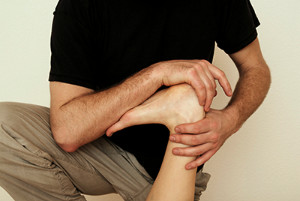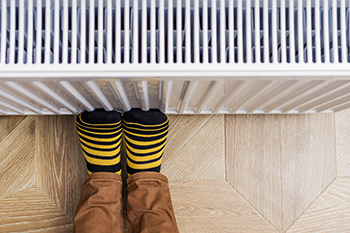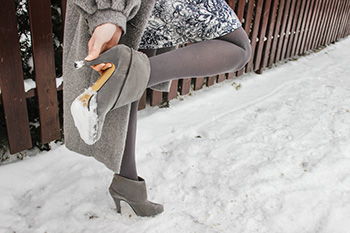Items filtered by date: March 2024
Tips for Buying Well-Fitting Shoes

To ensure proper shoe fit, measure both feet while standing and buy shoes for the larger foot. Choose shoes that match the shape of your feet, with ample toe room and proper arch support. Ensure about a thumb's width of space between the longest toe and the end of the shoe. Test shoe flexibility by bending it near the toe area. Check for any rubbing or discomfort when walking. Shop for shoes later in the day when feet are slightly swollen, and it is helpful to walk around the store to ensure comfort. If you would like additional advice on how to purchase shoes that fit well, it is suggested that you schedule an appointment with a chiropodist.
Finding the right shoes for you can ensure your comfort and help maintain proper foot health. If you suffer from foot pain and need help finding the right shoes for you, please consult with Chiropodist Stephanie Poupore from North Bay Foot & Ankle. Our clinician will assess your condition and provide you with quality foot and ankle treatment.
Tips to Find Great Shoes
Finding shoes that are well-fitting, supportive, and comfortable can be key in maintaining your overall foot health, but can sometimes seem like a monumental task.
Here are some tips and tricks to keep in mind when shopping for shoes.
Shop in a brick and mortar store - Your shoe size can change throughout your lifetime. You will be able to try on shoes before you buy them to ensure a proper fit. A salesperson can also provide recommendations on what shoes best serve your specific needs.
Try shoes on at the end of the day - Your feet swell throughout the day. By trying shoes on in the evening when the feet are at their largest, you ensure a good fit and shoes that are comfortable all day.
Have your feet measured - Find the right fit by having your feet measured at the shoe store. A salesperson can help by measuring both feet with a Brannock device to determine your true size.
Opt for comfort and support - Some shoes, such as high heels and flip flops, may look great but can cause damage to the feet over time. Look for shoes that have a low heel, adequate arch support, a wide toe box, and are made of breathable materials.
If you have any questions, please feel free to contact our office located in . We offer the newest diagnostic and treatment technologies for all your foot care needs.
Benefits of Exercise and Stretching the Feet

Exercise and stretching are encouraged for maintaining healthy feet. Regular physical activity helps improve circulation, strengthen muscles, and maintain flexibility in the feet and ankles. Activities such as walking, jogging, or swimming can enhance foot health by promoting blood flow and reducing the risk of conditions like peripheral artery disease and plantar fasciitis. Stretching exercises specifically targeting the feet and ankles can help prevent tightness and stiffness, improving overall mobility and reducing the likelihood of injuries. Simple stretches like toe curls, ankle circles, and calf stretches can help to alleviate tension and promote better flexibility in the foot muscles and ligaments. Additionally, exercises that focus on balance and body awareness, such as standing on one leg or using balance boards, can enhance stability and coordination, reducing the risk of falls and injuries. If you are seeking to maintain optimal foot health and overall well-being, it is suggested that you schedule an appointment with a chiropodist who can guide you toward effective foot and ankle exercises and stretches.
Stretching the feet can improve their flexibility and overall strength, and can help prevent or reduce the impact of foot injuries. For more information about stretching your feet, please consult with Chiropodist Stephanie Poupore from North Bay Foot & Ankle. Our clinician will assess your condition and provide you with quality foot and ankle treatment.
Why Stretching the Feet Is Important
Your feet support the weight of your entire body as you go about your daily activities. As with any other part of your body, stretching and exercising the feet can help maintain their overall health, reduce foot pain, and prevent future injuries.
How to Stretch
There are a variety of foot stretches and exercises that you may try. It is recommended that you speak with a chiropodist to learn which exercises are best for you.
Some examples include:
Heel Raises - Hold onto a wall for balance as you slowly rise up on your tiptoes. Hold the position for several seconds, then lower your feet back to the ground. Repeat 10 times.
Toe Splay - Sit in a chair with your feet flat on the ground. Spread your toes as far apart as you can, holding for several seconds. Repeat 10 times.
Towel Scrunches - Sit in a chair and lay a towel flat on the floor in front of you, placing your foot on top of it. Using only your toes, scrunch up the towel pulling it towards you. Repeat several times with each foot.
Plantar Fascia Massage - Sit in a chair and place a round or cylindrical object (such as a tennis ball, water bottle, or foam roller) under the arch of your foot. Slowly push your foot forward and backward while applying pressure to the object. Maintain the object between your heel and toes. Do this for about 30 seconds. Repeat on the other foot.
If you have any questions, please feel free to contact our office located in . We offer the newest diagnostic and treatment technologies for all your foot care needs.
We Can Treat Your Foot or Ankle Pain
Arthritis and the Cold

Winter can exacerbate arthritis symptoms, with cold weather and slippery surfaces posing challenges. However, there are strategies to maintain safety and wellness. Arthritis affects individuals differently. Some people experience worsened stiffness and pain in cold and damp conditions. Others may feel relief. Those with Raynaud's phenomenon face additional difficulties as cold weather restricts blood flow, leading to discomfort and numbness in extremities. Research indicates a correlation between weather conditions and pain levels in arthritis sufferers. To combat winter challenges, maintaining a warm home environment and wearing suitable clothing are important. Heat therapy, fall prevention measures, and adequate vitamin D intake are recommended. Staying physically active is paramount for managing arthritis, with options ranging from low-impact exercises to indoor activities. If you have arthritis and find that your pain worsens considerably in the winter months, it is suggested that you make an appointment with a chiropodist for a consultation and additional relief options.
The winter months can bring about new or worsening foot and ankle problems. If you’re suffering from foot or ankle pain, please consult with Chiropodist Stephanie Poupore from North Bay Foot & Ankle. Our clinician can help you maintain the health of your lower limbs and your mobility.
Winter Foot Problems
Cracked heels - Dry, cracked skin on the heels of the feet that is associated with cold, dry weather
Athlete’s foot - A fungal infection on the skin of the feet
Blisters - Fluid-filled bubbles of skin that usually form in response to friction
Fractures - Broken bones in the feet or ankles
Metatarsalgia - General foot pain
Chilblains - Spasming of the small blood vessels in the toes in response to exposure to cold weather
Raynaud’s disease - Numbness, pain, and color changes in the toes due to cold weather
Prevention
Wear warm socks and shoes
Avoid prolonged exposure to the cold
Moisturize the heels regularly
Keep your feet clean and dry
Walk carefully in areas that may be icy
Wear non-slip shoes
If you have any questions, please feel free to contact our office located in . We offer the newest diagnostic and treatment technologies for all your foot care needs.
Dangers of Wearing High Heels

High heels may exude style and confidence, but their allure comes with many foot-related perils that cannot be overlooked. Beyond mere discomfort, this type of shoe can induce a range of ailments as high heels force the foot into unnatural positions. The result is subjecting the forefoot to increased pressure and structural changes over time. Additionally, the impact extends beyond the feet, disrupting posture, gait, and balance, often leading to chronic back pain and a heightened risk of falls. Ankles and calves can also suffer, with restricted motion and muscle shortening culminating in conditions like Achilles tendonitis. Even the toes are not spared, with cramped toe boxes promoting deformities, such as hammertoe and painful corns and calluses. High-heel-related injuries are prevalent, with thousands of individuals seeking emergency care annually for sprains, strains, and other foot and ankle traumas. If wearing high heels has caused foot problems, it is suggested that you schedule an appointment with a chiropodist for relief and treatment options.
High heels have been in style for centuries, but unfortunately, they have also been damaging feet for centuries. If you would like to learn more about how high heels can hurt your feet, please consult with Chiropodist Stephanie Poupore from North Bay Foot & Ankle. Our clinician can help you maintain the health of your lower limbs and your mobility.
High heels can cause a variety of problems, including:
Foot and ankle pain
Foot and ankle injuries
Toe pain and deformities
Gait abnormalities
Achilles tendonitis
Changes in posture
Difficulty balancing
Leg, hip, and back pain
If you are reluctant to abandon your high heels, you can still wear them, but should take measures to minimize damage to your feet:
Wear shoes with heels no higher than 2 inches
Choose properly fitted shoes
Choose shoes with a wide toe box
Wear high heels infrequently
When wearing high heels, take them off periodically to stretch and relax your feet
If you have any questions, please feel free to contact our office located in . We offer the newest diagnostic and treatment technologies for all your foot care needs.

